Boning Knife vs. Fillet Knife: What’s the Difference?
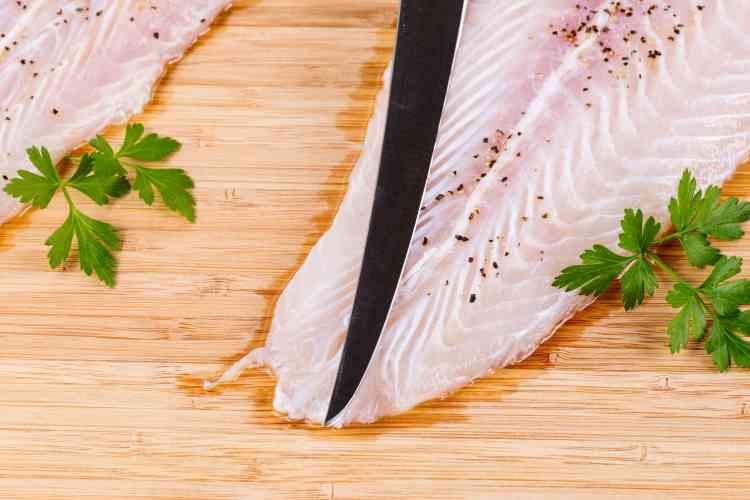
Have you ever wondered about the difference between a boning knife vs. a fillet knife? Do you really need to have both types of kitchen knives on your knife rack, or are they similar enough to be interchangeable if you’re trying to save space?
We’re here to answer your questions about these two types of knives so you can make an informed decision next time you’re shopping for cutlery. Read on to learn all about boning knives vs. fillet knives in this brief knife guide.
Jump to Section
- What Is a Boning Knife?
- Uses for a Boning Knife
- What Is a Fillet Knife?
- Uses for a Fillet Knife
- Boning Knife vs. Fillet Knife
What Is a Boning Knife?
When we’re discussing the differences between boning knives vs. fillet knives, we first need to understand what each knife is as well as the types of tasks one would normally use it for. Let’s start with boning knives. What is a boning knife, anyway?
What is a boning knife used for? As the name implies, boning knives separate bones from meat and fish. Most boning knife blades are between 5 and 7 inches long. They’re flat with sharp and slightly curved tips, making them perfect for carefully removing small bones. The blades tend to be stiffer than those on fillet knives, which also makes them effective for cutting through connective tissue or swiftly removing meat from thick bones.
If you’re in the market for a new boning knife, the Zwilling Pro 5.5" Flexible Boning Knife is an excellent option. With a 5.5-inch blade, this German-made, high-carbon stainless steel knife will make quick work of any bony meats.
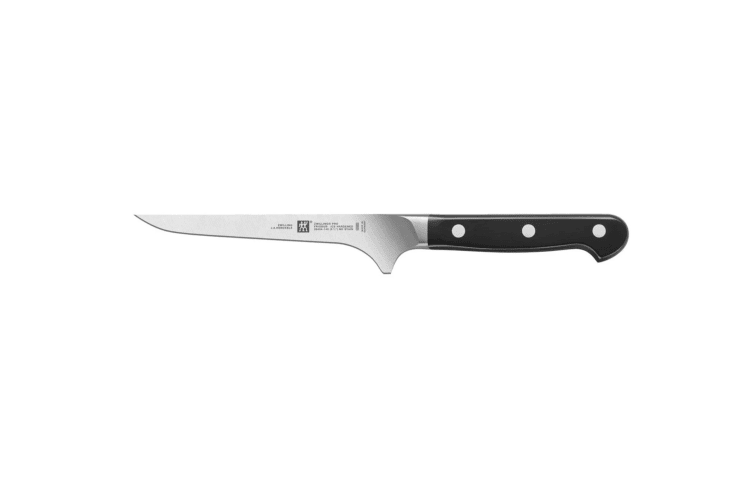
Uses for a Boning Knife
Now that we know what a boning knife is, let’s talk about why and when you may use one in your kitchen before we move further into the differences between boning knives vs. fillet knives.
Generally speaking, boning knives are for deboning fish and meat. In other words, they’re used for meat preparation. Smaller and more flexible boning knives are better for fish while larger and sturdier boning knives may be more effective for meat.
However, there are other ways to use a boning knife. In a pinch, you can also use it to prepare fruit and vegetables if you need precise cuts. Due to the sharpness of the knife, it’s perfect for things like removing corn from a cob or apple slices from the core while wasting as little food as possible.
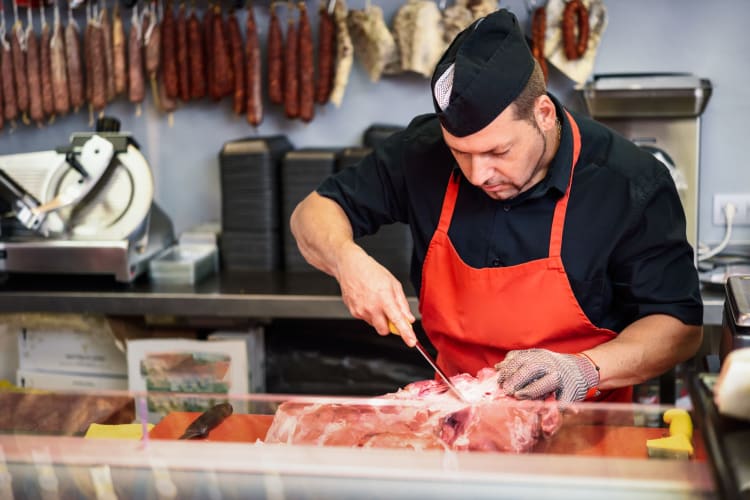
What Is a Fillet Knife?
Next in our explanation of boning knives vs. fillet knives, what is a fillet knife? Fillet knives are some of the best kitchen knives for people who eat a lot of seafood. They’re thin and flexible knives that measure between 5 and 11 inches, making them a fair bit longer than average boning knives. They were created for the exclusive purpose of delicately removing the scales of fish without wasting any meat.
Unlike the straight blades with curved tips of the boning knives, fillet knives have a strong upward curve along the entire blade (as well as a sharp curved tip). Fillet knives are thinner and less durable than your average boning knife, but this isn’t a bad thing per se. It allows them to perform more delicate tasks. This flexibility is one of the primary differences between boning knives vs. fillet knives.
The Dalstrong 7” Fillet Knife from their Gladiator Series is a great first fillet knife. It’s made from high-carbon German steel, and it has a comfortable handle. Its size makes it the perfect tool for both small tasks and larger cuts of meat.
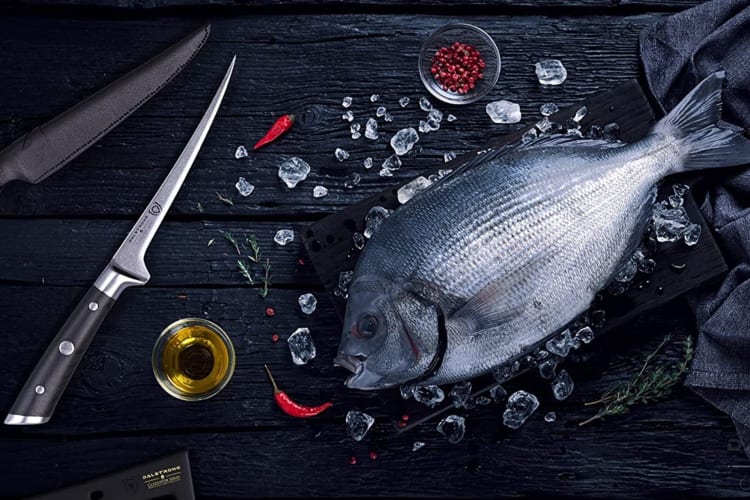
Uses for a Fillet Knife
Fillet knives have one main purpose: preparing fish. They’re helpful for all parts of the preparation process, from removing scales to removing bones. The sharpness and flexibility of a fillet knife make it the ideal tool for the job.
Fish flesh is delicate, and it’s easy to accidentally ruin the meat when you’re removing the scales or deboning it. A well-sharpened fillet knife will allow you to carefully prepare a fish with almost surgical precision. It can also be useful for thin cuts of meat, but when it comes to a boning knife vs. a fillet knife, a boning knife is the better option for non-fish meat.
You could, in theory, use a fillet knife for other things, but you’d risk damaging its sharp and flexible blade, rendering it less useful for its intended purpose. In other words, stick with preparing fish when you’re using your fillet knife.
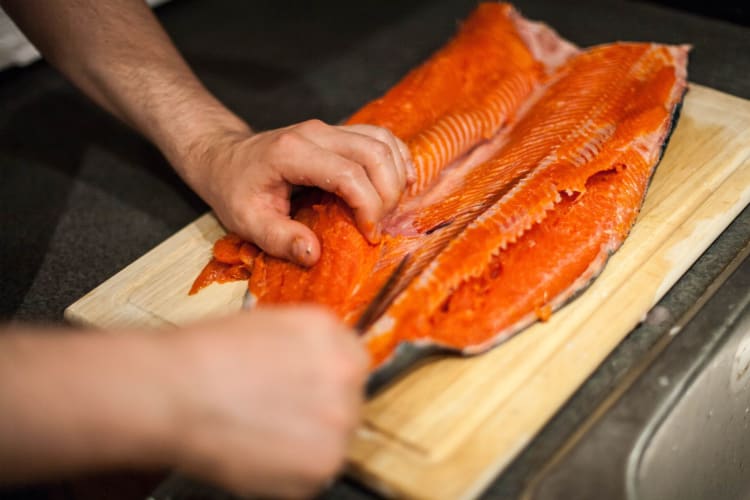
Boning Knife vs. Fillet Knife
Let’s do a quick breakdown of the differences and similarities between a boning knife vs. a fillet knife. We’ll go category-by-category so you have all of the information you need to make an informed choice about your next knife purchase.
-
Best Uses: Both fillet knives and boning knives are best used for preparing meat. However, when it comes to choosing between a boning knife vs. a fillet knife, the latter is the better choice if you’re preparing fish. The boning knife is the better choice for all other types of meat.
-
Blade Design: While both blades are thin, boning knives are thicker, sturdier and straighter than fillet knives. They share a sharp and curved tip, but fillet knives are more flexible and have a unique slender design that makes them ideal for removing scales and tiny bones from fish.
-
Cutting Action: Both boning knives and fillet knives are best used for delicate knife cuts and slices, and either can easily slice through flesh. Boning knives can also cut through connective tissue with a light sawing motion. Fillet knives can be used to “shave” the thin skin and scales from fish.
-
Blade Length: On average, boning knives are shorter than fillet knives. A boning knife blade will be somewhere between 5 and 11 inches long, while a fillet knife blade will be between 5 and 9 inches long.
-
Weight: Due to the large size variances with these knives, exact weights are unavailable. You can expect boning knives to be heavier due to their thicker and sturdier builds, however.
-
Price: Prices of these knives vary, but in general, you can expect high-end boning knives to run a bit more expensive than high-end fillet knives. This is likely due to their increased versatility. That said, they are still comparable.
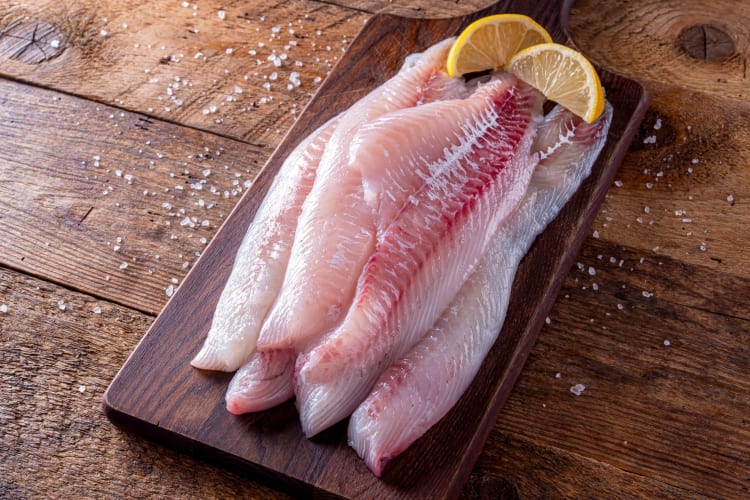
So, now that you know some of the differences and similarities between a boning knife vs. a fillet knife, which one are you adding to your “must-buy” list first? If you're a pescatarian or just love preparing fish, we recommend opting for a sleek and sharp fillet knife. If you want a more versatile tool that can help you prepare a variety of meats, a boning knife may be best. Whichever knife you choose, it’s sure to upgrade your home chef experience!
For even more ways to elevate your kitchen, check out chef-recommended cutlery in the Cozymeal Shop.



FOOD FOR THOUGHT?
Join the conversation.